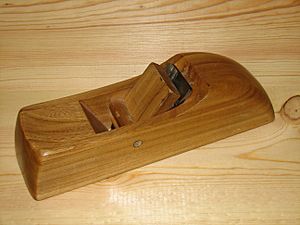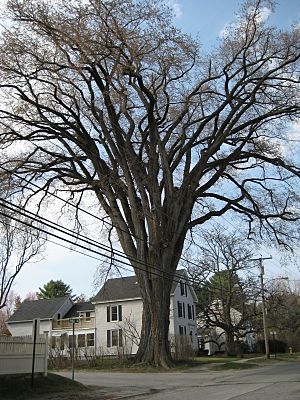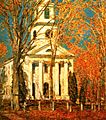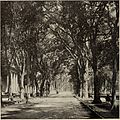Ulmus americana facts for kids
Quick facts for kids Ulmus americana |
|
|---|---|
 |
|
| Ulmus americana (American elm) in Northampton, Massachusetts | |
| Conservation status | |
| Scientific classification | |
| Genus: |
Ulmus
|
| Species: |
americana
|
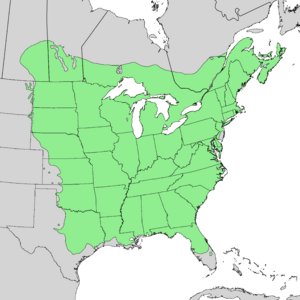 |
|
| Synonyms | |
|
|
The American elm (scientific name: Ulmus americana) is also known as the white elm or water elm. This tree is native to eastern North America, growing from Nova Scotia in Canada all the way south to Florida and central Texas in the United States.
The American elm is a very tough tree. It can survive cold winter temperatures as low as −42 °C (−44 °F). In places not affected by Dutch elm disease (DED), these trees can live for hundreds of years. For example, the Sauble Elm in Ontario, Canada, grew to be 43 meters (140 feet) tall. Its trunk was 196 cm (6.43 feet) wide before it died from DED in 1968. Tree rings showed it started growing in 1701.
For many years, scientists thought all American elms had double the usual number of chromosomes (called tetraploid). This made them unique among elms. However, a 2011 study by the Agricultural Research Service found that about 20% of wild American elms have the normal number of chromosomes (called diploid). Some special elm trees grown by people, like 'Jefferson', are very good at resisting DED. This disease caused a lot of damage to American elms in the 20th century. Scientists hope that the diploid trees might also be very resistant to the disease.
Contents
Understanding the American Elm Tree
How American Elms are Classified
Carl Linnaeus first described and named Ulmus americana in his book Species Plantarum in 1753. Today, scientists do not recognize any smaller groups or types within this species.
What American Elms Look Like
The American elm is a deciduous tree, meaning it loses its leaves in the fall. Before Dutch elm disease became a problem, these trees often grew over 30 meters (100 feet) tall. Their trunks could be more than 1.2 meters (4 feet) wide. They had a tall, wide, umbrella-shaped top.
Their leaves grow alternately on the branch. They are 7–20 cm long with jagged edges and a slanted base. The flowers are small and purple-brown. They are pollinated by the wind and do not have petals. The female parts of the flower mature before the male parts. This helps prevent the tree from fertilizing itself. The flowers appear in early spring before the leaves.
The fruit is a flat, round seed pod called a samara. It is about 2 cm long and 1.5 cm wide. A papery wing surrounds the single 4–5 mm seed. Like the European White Elm, the flowers and seeds grow on short stems. American elms are not affected by how long the day is. They keep growing into autumn until frost hurts them. Most American elms have 56 chromosomes, but sometimes they have 28.
Where American Elms Grow (Ecology)
American elms grow naturally in many different places. They are often found in rich lowlands, floodplains, along stream banks, and in swampy areas. However, they can also grow well on hillsides and in other places with good drainage. In higher areas like the Appalachian Mountains, they are usually found along rivers.
Their seeds are carried by the wind, which helps them spread quickly to new areas. American elms produce fruit in late spring, from February to June depending on the weather. The seeds usually sprout right away. Sometimes, some seeds might wait until the next year to sprout.
These trees grow best in the Northeastern United States. Elms in the Deep South and Texas grow smaller and do not live as long. However, more of them survive in these warmer regions because the climate is less favorable for Dutch elm disease to spread.
In the United States, the American elm is a key part of four main forest types:
- Black ash-American elm-Red maple forests
- Silver maple-American elm forests
- Sugarberry-American elm-Green ash forests
- American sycamore-sweetgum-American elm forests
The first two types also grow in Canada. A Sugar maple-ironwood-American elm forest type can be found on some hilltops near Témiscaming, Quebec.
The leaves of the American elm are food for the young forms (larvae) of many butterflies and moths. These include butterflies like the Eastern Comma, Question Mark, Mourning Cloak, Painted Lady, and Red-spotted Purple. Moths like the Columbian Silkmoth and the Banded Tussock Moth also eat elm leaves.
Challenges for American Elms
Pests and Diseases Affecting Elms
The American elm is very vulnerable to Dutch elm disease (DED) and elm yellows. In North America, there are three types of elm bark beetles. One is native, called the "native elm bark beetle." Two others are invasive: the "smaller European elm bark beetle" and the "banded elm bark beetle." These beetles can harm weak trees by feeding on them. However, their main danger is that they carry the DED fungus.
American elms are also a favorite food for the adult elm leaf beetle and the Japanese beetle in the United States.
U. americana is also the most likely of all elms to get verticillium wilt. The signs of this disease look a lot like DED. But verticillium wilt is much less serious, and affected trees usually get better the next year.
Dutch Elm Disease (DED)
Dutch elm disease (DED) is a fungal disease that has caused huge numbers of American elms to die. It has wiped out trees in cities across their natural range. Scientists believe that only about 1 in 100,000 American elm trees can tolerate DED. Most known surviving trees simply haven't been exposed to the disease yet.
However, in some areas where DED has not spread, American elms are still doing well. These areas include Florida, Alberta, and British Columbia. There is a famous group of old American elm trees in Manhattan's Central Park. These trees seem to have been saved because they are isolated in such a busy city.
American elms are especially vulnerable to DED because the time when the disease infects them often matches the time when new wood vessels are growing fast in the spring. If spores enter the tree outside of this time, they mostly stay still in the wood and do not cause much harm.
The way American elms grow has helped save them from being completely wiped out by DED. This is different from what happened to the American chestnut with the chestnut blight. Elm seeds are mostly spread by wind. The trees grow quickly and start making seeds when they are young. They grow well along roads, railroad tracks, and in empty lots. They can handle many stressful conditions.
Elms have been able to survive and reproduce in areas where the disease killed older trees. However, most of these young elms eventually get the disease when they are still young. There is hope that these elms will keep the genetic variety of the original population. They might also mix with DED-resistant types that scientists have developed or that occur naturally. After 20 years of research, American scientists created DED-resistant types of elms in the late 1990s.
Elms in forests and other natural areas have been less affected by DED than trees in cities. This is because they face less stress from pollution and soil problems. Also, they grow in smaller, more spread-out groups.
Special injections can be given to valuable American elms to stop them from getting infected. These injections usually work for up to three years if given before any signs of the disease appear. But they might not work once the disease is already visible.
Growing and Using American Elms
Cultivating American Elms
In the 1800s and early 1900s, the American elm was a popular tree for streets and parks. This was because it could handle city life, grew fast, and had a beautiful shape. However, too many of these trees were planted, especially to create archways over streets. This created a situation where almost all the trees were the same type (a monoculture). These trees had no natural defense against diseases and pests.
Elms do not naturally grow in large groups of only one type. The trees used in landscaping came from only a few specific varieties. This meant there was very little genetic variety among them. The trees' fast growth and long life, which allowed them to become very large in a few decades, also made them popular for planting before DED appeared.
Ohio botanist William B. Werthner described how American elms looked different when grown in the open compared to in a forest: "In the open, with plenty of air and light, the main trunk splits into several large branches. These branches grow upwards, slowly spreading out and dividing into many long, flexible smaller branches. Their ends gently float in the air, giving the tree a round, somewhat flat top with beautiful, even shapes and delicate twigs."
This special shape is what people loved about American elms grown in open spaces like streets, lawns, and parks. Along most narrow streets, elms planted on opposite sides would arch over and meet, forming a leafy tunnel over the road. However, elms can have many different sizes and shapes depending on where they grow and the climate. The classic vase-shaped elm was mostly created by choosing specific varieties to grow. It is much less common to see this shape in the wild.
Gallery of American Elm Trees
-
Lafayette Street, Salem, Massachusetts: 'high-tunnel effect' of U. americana avenues once common in New England (colorized postcard, 1910).
-
Rows of American elm trees lining the sides of a path traversing the length of the National Mall in Washington, D.C. (April 2010).
-
Ulmus americana as campus elm: Cambridge, Massachusetts.
-
American elm, Old Deerfield, Massachusetts (2011). Girth was 19.3 ft at 4.5 ft above ground; height 106.8 ft; avg. crown spread 105 ft. This tree died in 2017.
-
Same American elm, Old Deerfield, Massachusetts (2012). This tree died in 2017.
-
American elm, Hatfield, Massachusetts (2020). Measurements as of November 2019: girth 17.5 ft, 11 in at 4.5 ft above ground; height 86 ft; spread 87 ft.
-
"The Grayson Elm" in Amherst, Massachusetts in winter. American elm, Massachusetts (2013), with octopus-like limbs. Girth 17 ft; height 80 ft.
-
"The Grayson Elm" in Amherst, Massachusetts in summer (2017).
-
"The Grayson Elm" in Amherst, Massachusetts in fall (2020).
-
American Elm in Johnstown, New York. (2013). 199 inches in circumference and 90 feet tall. Now deceased.
-
American elms, Central Park, Manhattan, New York City (Spring 2011).
-
Large American elm in New Haven, Connecticut (June 2017). Girth over 18.5 ft; height 88 ft; spread 95 ft. This tree died in 2019.
-
West Hartford Elm - Large American elm in West Hartford, Connecticut (May 2017). Girth 16 ft, 3 inches at 4.5 ft above ground; height 74 ft; spread 97 ft.
-
American elm in Charlottetown, Prince Edward Island, Canada (August 2019).
-
Old American elm in Halifax Public Gardens, Nova Scotia, Canada (August 2019).
-
Elm tree on Elm Street in Plaistow, New Hampshire, which was planted in the late 1800s (August 2019). Girth 13 ft at 4.5 ft above ground; height 85 ft; spread 80 ft.
-
American elm in front of the Florence K. Murray Courthouse in Newport, Rhode Island (August 2015).
-
Ulmus americana (American elm) at Longwood Gardens, Kennett Square, Pennsylvania (May 2004).
-
American elm at Dartmouth College in Hanover, New Hampshire (June 2015).
-
American elm located at the Hill-Stead Museum in Farmington, CT (July 2019).
-
American elm at Phillips Academy, Andover, MA (May 2020).
-
American elm tree in Springfield, Massachusetts, which survived the tornado that touched down in this part of the city in 2011 (June 2020).
-
American elm tree in Adams, Massachusetts (August 2020).
American elms have been planted outside their natural range in North America. They grow as far north as central Alberta. They can also survive the heat of low deserts, like in Phoenix, Arizona.
Attempts to grow American elms in the UK rarely worked well, even before DED spread. The tree was brought to the UK in 1752. It was found to be much more likely to get insect damage on its leaves than native elms.
Special Types of American Elms (Cultivars)
Many special types of American elms, called cultivars, have been developed. At first, they were chosen for their beauty. More recently, they have been chosen for their ability to resist Dutch elm disease. There are about 45 named cultivars. At least 18 of these have probably been lost due to DED or other reasons.
Some disease-resistant types available today include 'Valley Forge', 'New Harmony', 'Princeton', 'Jefferson', 'Lewis & Clark', 'Miller Park', 'St. Croix', and a group of six different types called 'American Liberty'. The United States National Arboretum released 'Valley Forge' and 'New Harmony' in 1995. Tests showed they had very high resistance to DED. 'Valley Forge' did especially well.
'Princeton' has been grown occasionally since the 1920s. It became popular again after tests in 1992–1993 showed it also had strong disease resistance. Later tests in 2002–2003 confirmed that 'Princeton', 'Valley Forge', and 'New Harmony', as well as 'Jefferson', were resistant. So far, planting these four types seems to be working well.
In 2005, about 90 'Princeton' elms were planted along Pennsylvania Avenue in front of the White House in Washington, D.C.. These trees are managed by the National Park Service (NPS) and are healthy. However, some experts say that planting only one type of U. americana is not recommended. This is because they still have some DED and elm yellows concerns.
Planting only one type of U. americana (like on Pennsylvania Avenue) makes them more vulnerable to disease. Also, long-term studies of 'Princeton' in Europe and the United States suggest its DED resistance might be limited.
The National Elm Trial studied 19 elm cultivars sold in the United States. This trial, which started in 2005 and lasted ten years, compared their strengths and weaknesses. Based on the final results, 'New Harmony' and 'Princeton' are the preferred types of U. americana.
'Jefferson' was released to nurseries in 2004 and is becoming more available. However, 'Jefferson' has not been widely tested outside Washington, D.C. The National Elm Trial did not have data on 'Jefferson'. This was because of a mistake in tree identification in nurseries. This mistake might still cause nurseries to sell 'Princeton' elms labeled as 'Jefferson'. But you can tell the two types apart as the trees grow older.
In 2007, the 'Elm Recovery Project' at the University of Guelph in Canada reported good news. They grew cuttings from healthy old elms in Ontario. This created a group of resistant trees. These trees are now being used to breed new, highly resistant types.
Scientists are also using genetic engineering techniques to create DED-resistant American elms. In 2007, researchers reported that young genetically modified American elms showed fewer DED symptoms. By 2013, scientists were testing genetically engineered DED-resistant American elms in fields in New York State and North Carolina.
Hybrid Elms
- Ulmus 'Rebella' (a mix of U. americana and U. parvifolia)
Scientists tried thousands of times to cross the American elm with the Siberian elm (Ulmus pumila), but they failed. Attempts at the Arnold Arboretum with ten other elm species also failed. This was thought to be due to differences in chromosomes and how flowers mature.
Success finally came with the Chinese elm (Ulmus parvifolia), which flowers in autumn. Professor Eugene Smalley at the University of Wisconsin–Madison managed to keep Chinese elm pollen alive until spring. Only one of these mixed types was sold, as 'Rebella' in 2011 by a German nursery. This type is not available in the United States.
Other claims of mixing American elm with other species are rare and viewed with doubt. Two such claims were 'Hamburg' and 'Kansas Hybrid', both supposedly mixed with Siberian elm. However, since research institutions repeatedly failed to mix these two species, it is now believed that the "American elm" in those cases was more likely the red elm, Ulmus rubra.
Other Uses for American Elm Trees
Elm Wood
The wood of the American elm is rough, hard, and tough. Its fibers are tangled and twisted, making it hard to split or chop. It also tends to warp after being cut. Because of this, the wood was not used much at first, except for making hubs for wagon wheels.
Later, with mechanical saws, American elm wood was used for barrel parts, trunk-slats, and hoop-poles. It then became very important for making wooden automobile bodies. Its tangled fibers held screws unusually well.
Traditional Uses
The young twigs and small branches of the American elm have strong, fibrous bark. This bark was used for tying and binding things. It was even used to make rope swings for children and for making whips.
Famous American Elm Trees
Many American elms now survive in forests, suburban areas, and sometimes cities. These surviving trees are often somewhat isolated from other elms. This has helped them avoid severe exposure to the fungus. For example, in Central Park and Tompkins Square Park in New York City, groups of large elms planted by Frederick Law Olmsted are still alive. This is because they are isolated from nearby areas in New York where many elms died.
A line of old American elms runs along Central Park, from 59th to 110th Streets. In Akron, Ohio, there is a very old elm tree that has not been infected. In historic areas of Philadelphia, Pennsylvania, a few old American elms still stand. These include trees in Independence Square and at the University of Pennsylvania. There are also trees at Haverford College, Swarthmore College, and Pennsylvania State University. The group at Penn State is believed to be the largest remaining group in the country.
There are several large American elm trees in western Massachusetts. A big tree on Summer Street in Lanesborough, Massachusetts, has been kept alive with special treatments. Rutgers University has saved 55 old elms on and near Voorhees Mall in New Brunswick, New Jersey. They have also planted seven disease-resistant trees in this area recently.
The largest surviving urban forest of American elms in North America is thought to be in Winnipeg, Manitoba, Canada. Close to 200,000 elms remain there. The city of Winnipeg spends $3 million each year to fight the disease. They use treatments and a vaccine, losing 1500–4000 trees per year.
Many states in the United States keep lists of their largest American elm trees. The current national champion American elm tree is in Iberville Parish, Louisiana. When measured in 2010, its trunk was 324 inches (823 cm) around. It was 111 feet (34 meters) tall, and its top spread 79 feet (24 meters) wide.
The current champion in the Tree Register of the British Isles (TROBI) grows in Avondale Forest near Rathdrum, County Wicklow, Ireland. In 2000, this tree was 22.5 meters (74 feet) tall. Its trunk was 98 cm (39 inches) wide.
Other large or important American elm trees include:
The Treaty Elm
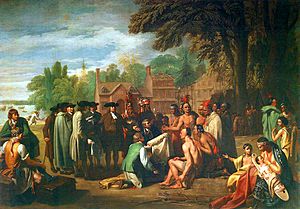
The Treaty Elm was in Philadelphia, Pennsylvania. In what is now Penn Treaty Park, William Penn, who founded Pennsylvania, is said to have made a peace treaty in 1683. He met with the Lenape Turtle Clan under a beautiful elm tree. This tree became famous in a painting by Benjamin West. West included the tree in his painting after hearing stories that the treaty happened there. However, there is no written proof that Penn signed any treaty under a specific tree.
On March 6, 1810, a big storm blew the tree down. Measurements taken at the time showed it was 24 feet (7.3 meters) around. Its age was estimated to be 280 years. Wood from the tree was made into furniture, canes, and other small items. People in Philadelphia kept these as souvenirs.
The Washington Elm (Massachusetts)
The Washington Elm was in Cambridge, Massachusetts. George Washington is said to have taken command of the American Continental Army under this tree on July 3, 1775. The tree lived until the 1920s and was thought to be a very old forest survivor. In 1872, a large branch fell from it. This branch was used to build a pulpit for a nearby church.
The tree became a famous attraction. It had its own plaque, a fence around it, and a road was even moved to help save it. The tree was cut down in October 1920 after an expert said it was dead.
The city of Cambridge planned to "carefully cut it up and send a piece to each state of the country." A professor examined the tree rings days after it was cut down. He said it was between 204 and 210 years old. This means it was at most 62 years old when Washington took command.
In 1896, a student from the University of Washington got a rooted cutting from the Cambridge tree. This cutting was planted. Then, cuttings were taken from it. One was planted on February 18, 1932, the 200th birthday of George Washington. That tree is still on the campus of the Washington State Capitol.
The Washington Elm (District of Columbia)
George Washington's Elm was in Washington, D.C.. George Washington supposedly had a favorite spot under an elm tree near the United States Capitol Building. From there, he would watch the building being constructed. This elm stood near the Senate side of the Capitol building until 1948.
The Logan Elm
The Logan Elm near Circleville, Ohio, was one of the largest American elms in the world. This 65-foot (20-meter) tall tree had a trunk that was 24 feet (7.3 meters) around. Its top spread 180 feet (55 meters) wide. Weakened by DED, the tree died in 1964 from storm damage. The Logan Elm State Memorial marks the spot and keeps various monuments there. People say that Chief Logan of the Mingo tribe gave a powerful speech under this elm in 1774.
"Herbie"
Another famous American elm was named Herbie. It was the tallest American elm in New England until it was cut down on January 19, 2010. It died after getting DED. Herbie was 110 feet (34 meters) tall at its tallest. Its trunk was 20.3 feet (6.2 meters) around, or about 6.5 feet (2 meters) wide. The tree stood in Yarmouth, Maine. The town's tree warden, Frank Knight, took care of it.
When it was cut down, Herbie was 217 years old. Herbie's wood is interesting to scientists who study past climates using tree rings. They will use pieces of its trunk to learn about the climate during the tree's long life.
The Glencorradale Elm
The Glencorradale Elm on Prince Edward Island, Canada, is a wild elm that is believed to be several hundred years old. It is a rare survivor.
The Survivor Tree
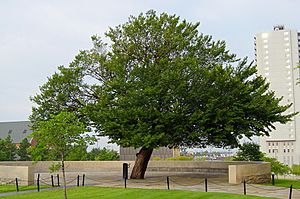
An American elm in a parking lot across from the Alfred P. Murrah Federal Building in Oklahoma City survived the Oklahoma City bombing on April 19, 1995. This bombing killed 168 people and destroyed the building. The tree was damaged, with pieces of debris stuck in its trunk and branches. It was almost cut down during the search for evidence. However, almost a year later, the tree began to bloom. It became known as the Survivor Tree. It is now an important part of the Oklahoma City National Memorial and is shown on the memorial's official logo.
The Parliament Hill Elm
The Parliament Hill Elm was planted in Ottawa, Canada, in the late 1910s or early 1920s. This was when the Centre Block building was rebuilt after a big fire in 1916. The tree grew for about a century next to a statue of John A. Macdonald. It was one of the few in the area to survive the spread of DED in the 1970s and 1980s. Despite protests from environmentalists and politicians, the tree was removed in April 2019. This was to make way for new renovations to the Centre Block.
American Elms in Landscaped Parks
Central Park's Elms
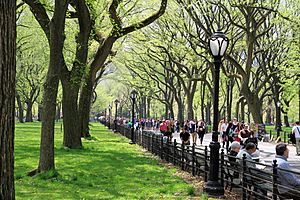
New York City's Central Park has about 1,200 American elms. This is more than half of all the trees in the park. The oldest of these elms were planted in the 1860s by Frederick Law Olmsted. This makes them some of the oldest groups of American elms in the world. The trees are especially famous along the Mall and Literary Walk. Here, four lines of American elms stretch over the path, creating a beautiful, cathedral-like cover.
These elms are a key part of New York City's urban ecology. They help improve air and water quality, reduce soil erosion and flooding, and lower air temperatures on warm days.
While the trees are still at risk from DED, the Central Park Conservancy started strong efforts in the 1980s. They heavily pruned and removed trees that were very diseased. These efforts have largely succeeded in saving most of the trees, though a few are still lost each year. Younger American elms planted in Central Park since the disease outbreak are the DED-resistant 'Princeton' and 'Valley Forge' types.
The National Mall's Elms
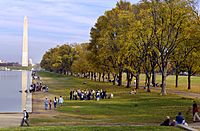
Several rows of American elm trees line much of the 1.9-mile (3.0 km) National Mall in Washington, D.C.. The National Park Service first planted these trees in the 1930s. DED first appeared on these trees in the 1950s and was worst in the 1970s.
The NPS used many ways to control the disease. These included cleaning up diseased wood, pruning, injecting trees with fungicide, and planting new DED-resistant types. The NPS fought the disease's insect carrier, the smaller European elm bark beetle, by trapping them and spraying with insecticides. Because of these efforts, the American elm population on the Mall has stayed healthy for over 80 years.
American Elms in Art and Photography
The beauty and arching shape of the American Elm were celebrated in books of photographs. These books showed elms on farms, in villages, towns, and on college campuses. Photographers like Wallace Nutting and Samuel Chamberlain captured their grace. Frederick Childe Hassam is a famous painter who often showed American Elms in his artworks.
-
George Inness, 'Old Elm at Medfield'
-
American elm avenue, New Haven, Connecticut (1901), Thomas Meehan and Sons catalogue
Images for kids
-
Ulmus americana (American elm) in Northampton, Massachusetts
See also
 In Spanish: Olmo americano para niños
In Spanish: Olmo americano para niños












































